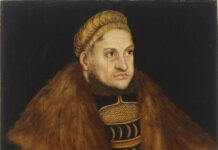A Testimony to the Habsburgs’ Claim to Power: The Three Emperors Issue
Künker offers two gold coins of the so-called Three Emperors Issue as part of the sale of the Salton Collection. We summarize what is known about these mysterious pieces, which are symbolic of Habsburgs’ claim to power.
Germany’s False Start: The Unsuccessful Imperial Election of 1849
The German Constitutional National Assembly at St Paul’s Church in Frankfurt was one of the greatest achievements of the German revolutions of 1848. On 28 March 1849, the assembly elected Frederick William IV as Emperor of a unified Germany. Too bad that he did not want to be German Emperor in the first place!
Why the Munich Marienplatz Is Called Marienplatz
Our cities have evolved through history, and every architectural detail is connected to this history. We explain why the Munich Schrannenplatz (Grain Market Square) was renamed Marienplatz (Mary’s Square), using coins that will be on offer at Künker’s 2022 January Auction Sales as illustrations.
A Festival for St Wenceslas
St Wenceslas is the central motif on Czechoslovak commemorative coins. And there is a good reason for it: in 1929, 750,000 believers celebrated the 1000th anniversary of his death. A coin series issued between 1923 and 1936 – on offer at Künker on 26 January 2022 – demonstrates how important St Wenceslas was for young Czechoslovakia.
Who Was Frederick the Wise?
We all think we know him: Frederick the Wise who hid Luther at Wartburg Castle to protect him from imperial reprisals. As part of the Köhlmoos Collection, Künker will offer some coins featuring his portrait on 26 January 2022 that help us look beyond the myth.
From Lira to Euro. Italy’s History in Coins – Part 7: The Church and Fascism
In 1929, the Vatican and Italy signed the Lateran Treaty. This international agreement was the ultimate accolade for Mussolini. The Duce dreamed of an Italian empire in Africa and around the Mediterranean Sea. However, this dream turned into a nightmare.
From Lira to Euro. Italy’s History in Coins – Part 6: The Invention of Fascism
After the First World War, Italy suffered from frustrated nationalism and inflation. The left-wing journalist Benito Mussolini made use of this environment. He switched sides and, within a few years, seized power by force and ended up at the top of a fascist dictatorship.
From Lira to Euro. Italy’s History in Coins – Part 5: South Italy and the Mafia
When the big landowners in South Italy started to spend an increasing amount of time away from their estates, a phenomenon emerged that still plagues Italy today: the mafia. Since the unification of Italy, organized crime has exerted massive influence on politics.
Heavy Gold Coins – A Special Gift for Special People
Have you ever wondered why there were so many large gold coins weighing several ducats in the early modern period? We’ll show you with the help of some spectacular examples from the upcoming Numismatica Genevensis auction.
A New Pattern from Germany of the Yunnan Dragon Dollar
Heidelberger Münzhandlung presents a new testimony to the active cooperation between China and Germany: a pattern of the Dragon Dollar for Yunnan, produced with German minting presses.












